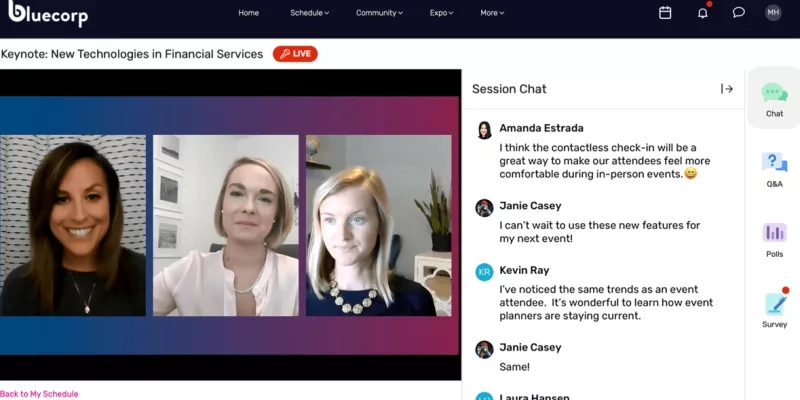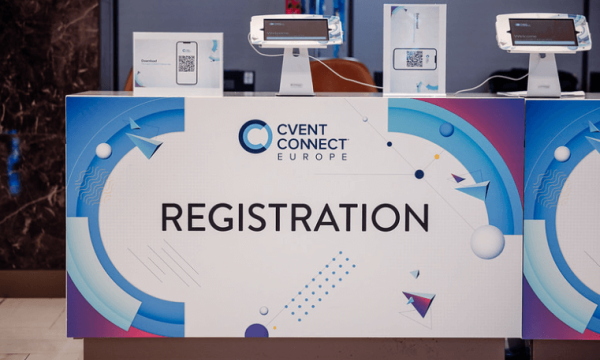While a lot has changed over time in terms of technology, there is one constant in an ever-changing universe: Webinars, when done correctly, are a powerful tool to engage remote audiences and drive business goals. Notably, they are a favored marketing medium, with the global market expected to hit USD 5 billion by 2035, boasting a CAGR of ~8% from 2023 to 2035.
This blog post will guide you in setting clear webinar objectives and evaluating success using key metrics. Dive in for insights that will elevate your webinar strategy.
What is a Webinar?
A webinar is a live, virtual event conducted over the Internet. Its primary purpose is to provide information, training, or education to a remote audience through an online webinar platform, allowing real-time interaction between the presenter and the attendees. Attendees can participate from anywhere in the world, interact with the presenter, ask questions, and engage in discussions.
What you can gain from webinars:
- Knowledge: Dive into your industry's latest trends, insights, and best practices.
- Networking: Connect with experts, professionals, and peers, even from the comfort of your home.
- Flexible Learning: Absorb information at your own pace, often with the option to rewatch.
- Cost Savings: Eliminate travel expenses and learn directly from your workspace or home.
- Access to Experts: Hear from and interact with top professionals who might be otherwise inaccessible.
- Resources: Often, webinars come with additional resources or tools to aid in understanding.
Why are Webinar Goals Important?
Setting webinar goals is akin to having a roadmap for a journey. Without clear objectives, you might wander without direction or purpose. By establishing goals, you provide clarity and focus for your presentation. Furthermore, these objectives allow you to gauge the effectiveness and success of your webinar, ensuring that your content remains targeted and impactful. Simply put, without goals, you're navigating without a compass.
Types of Webinar Goals with Examples
There are different types of goals for webinars. They usually depend on multiple factors, including your business objective and industry. As you plan your next webinar, consider these primary goals to enhance its impact:
Lead generation: Generate 50 new sales-qualified leads from the webinar promotion and registration process. Have at least 30 attendees fill out lead capture forms during the webinar.
Lead generation KPIs:
- Leads generated
- Contact information collected
- Lead conversion rate
For example, you collected 60 new leads from the 100 attendees, so your conversion rate is 60%.
Brand awareness: Position our company as a thought leader in [industry] by hosting a webinar highlighting our latest product innovations. Use social media and email campaigns to reach 500 people with webinar promotion.
Brand awareness KPIs:
- Website Traffic
- Brand keyword searches
- Social followers
For example, your website traffic increased by 15%, and brand keyword searches increased by 10% after the webinar.
Attendance: Achieve at least 100 registrants through webinar marketing. Target a minimum of 75 attendees at the live event for a 75% attendance rate.
Attendance KPIs:
- Number of live attendees
- Attendee turnout ratio
- Attendee dropout ratio
For example, you had 100 registrations and 50 live attendees, so your turnout ratio is 50%. Of those 50, 10 dropped off early, so your dropout ratio is 20%.
Engagement: Keep at least 60% of live webinar attendees interacting through polls, Q&A, and other engagement features. Measure engagement rate through webinar software analytics.
Engagement KPIs:
- Poll participation
- Questions asked
- Chat messages
- Social shares and mentions
For example, you had 25 poll responses, 15 questions asked, and 50 social shares during the webinar.
Conversions: Convert 10% of webinar registrants into customers of our software by promoting a limited-time offer.
Sales impact KPIs
- Attributed sales revenue
- Sales influenced by webinar
- Pipeline influenced
For example, 5 webinar attendees became customers in the next quarter, contributing $50,000 in sales revenue.
Satisfaction: Receive a rating of at least 4 out of 5 stars from 80% of webinar attendees based on post-event survey feedback.
Satisfaction KPIs
- Average satisfaction rating from post-event surveys
- Percentage of attendees rating 4 or 5 stars
- Net Promoter Score (NPS) from surveys
For example, your post-webinar survey had an average satisfaction rating of 4.7 out of 5 stars. 85% of attendees rated the webinar 4 or 5 stars. And your NPS score from the surveys was 75.
Registrations: Generate 250 registrations for the webinar through social media and email marketing outreach. Target at least 200 attendees to achieve an 80% attendance rate.
Registration KPIs
- Number of registrations
- Registration sources (email, social media, ads, etc.)
- Registration conversion rate
For example, you had 1,000 website visitors and 100 registered, so your conversion rate is 10%.
Related: 26 Webinar Best Practices
Ways for Setting Realistic Webinar Goals
Setting the right goals for your webinar is pivotal to achieving tangible success. The more aligned and realistic your objectives are with your business needs, the better the outcomes. Here are some ways to align and achieve your webinar goals:
- Align with Business Objectives: Identify your core business goals. Are you seeking more traffic, better sales, or heightened brand awareness? Do you want to upsell more to your basic-plan customers?
Tailor your webinar objectives to support these goals and consult with your marketing team to align strategies. - Have Clear Webinar Goal Strategies: Crafting a detailed plan boosts your success likelihood. Ensure everyone on the team understands their role and keeps the focus on the objectives.
- Regularly Monitor Progress: Stay proactive by regularly reviewing webinar metrics like email responses and live attendance. This enables timely interventions if things veer off track.
- Be Ready to Pivot: While sticking to a plan is beneficial, be adaptable when needed. If adjustments are essential, collaborate with your marketing team to realign.
- Consistency is Key: Instead of frequently shifting focus, allow your initial strategy to play out. If an overhaul is justified, ensure it's a collective decision with your marketing team.
Lastly, leverage tried-and-true frameworks to sharpen your goals. Tools like SMART (Specific, Measurable, Achievable, Relevant, Time-bound) and OKR (Objectives and Key Results) can offer invaluable structure, ensuring your webinar goals are purposeful and achievable.
Measure Webinar Success With These KPIs
Here are 16 essential webinar metrics to help assess engagement, lead generation, branding, and overall event efficiency:
Evaluate Registration and Traffic
- Track Registrations vs. Click-Through Rate
Monitor how many people register after clicking on your promotional materials. This lets you see how enticing your content topic and the design of your landing page are in getting people to commit.
- Calculate Webinar Costs
Ensure you know all your expenses—from promotion and marketing to the webinar technology you're using—to figure out how cost-effective your webinar strategy is. It's also crucial to understand the cost of acquiring a single registration based on where they came from and the audience type.
Measure Attendance and Engagement
- Analyze Attendee Turnout Ratio
Once people have registered, see how many of them show up. This tells you how compelling your promotional efforts are in turning interests into actions.
- Evaluate Attendee Dropout Ratio
Notice when attendees drop out before your webinar finishes. If this number is high, something about your content or delivery might not resonate.
- Track Attendee Intent Signals
Keep track of who's asking questions, who wants a demo, or who's showing other interest signs during your webinar. These are potential leads you don't want to miss.
- Analyze Webinar View Duration
See how long your attendees stay engaged. If they're dropping off early, your content may need adjustment.
- Measure Engagement During Webinar
Create engaging webinars with polls, Q&As, and other interactive features. Tracking participation gives you a direct measure of audience involvement.
- Capture Attendee Feedback
Always be in the loop about what your attendees think. Use surveys or even track social media discussions to refine your approach.
Quantify Lead Generation and Conversions
- Calculate Conversion Rate to Leads
Find out how many of your attendees turn into genuine leads. This is a direct reflection of the quality and relevance of your content.
- Track On-Demand Replays
Your content can still draw interest even after the live event. By monitoring how often the recording is viewed, you extend the life and reach of your webinar.
Measure Business Impact
- Assess Webinar-to-Sales Conversion
Tracking how many attendees take the next step and purchase indicates your webinar's direct impact on revenue.
- Evaluate Influenced Pipeline
Understand how your webinar nudges potential customers down the sales funnel. This shows the webinar's contribution to your overall sales process.
- Calculate Webinar ROI
By understanding the revenue you've generated versus your costs and influenced sales, you can see the return on your investment.
Analyze Ongoing Engagement
- Track Post-Webinar Retention
After your webinar, monitor if attendees engage with your site and resources. This indicates the lasting impact of your content.
- Measure Brand Awareness
Post-webinar, gauge the chatter around your brand on search engines, social platforms, and site visits to understand any boost in brand recognition.
Optimize Delivery and Content
- Evaluate Webinar Session Length
It's essential to find the sweet spot for your webinar duration. You can better adjust your content and timing by identifying when attendees typically drop off.
By keeping these points in mind, you'll have a comprehensive strategy to ensure your webinars are as effective as possible.
Also read: The ultimate webinar checklist for 2023
Conclusion
There you have it—a complete guide to crushing your webinar goals and tracking metrics to quantify your success. With the right webinar goal strategies, you can host them to drive leads, boost brand awareness, and deliver impressive ROI.
Remember to align your goals with broader business objectives and keep your attendees engaged from promotion to follow-up. Just follow these best practices, and you'll be well on your way to webinar success.













